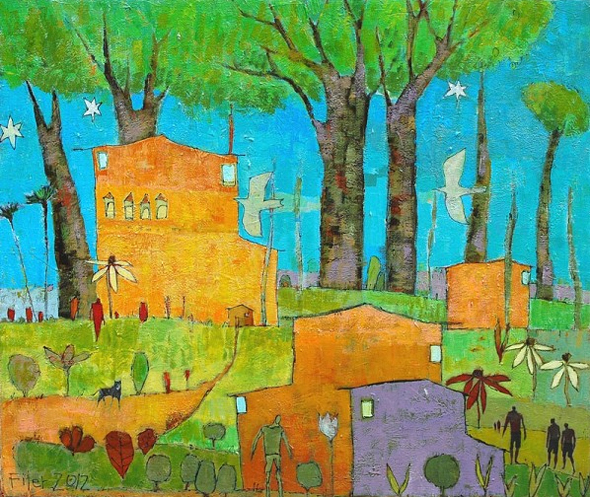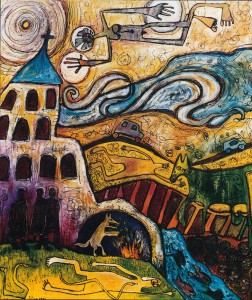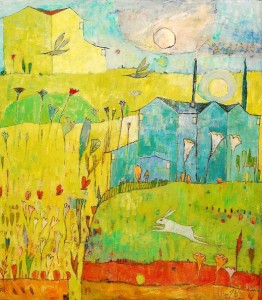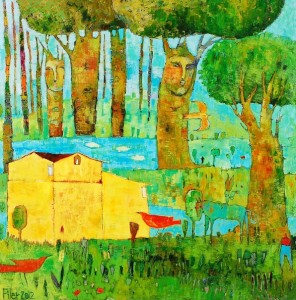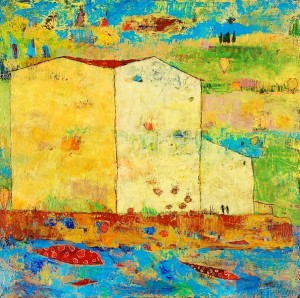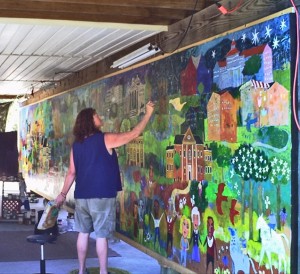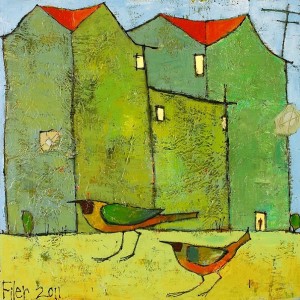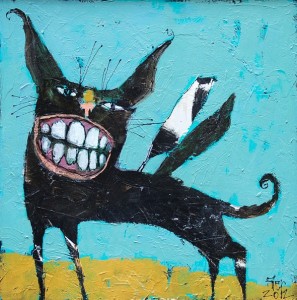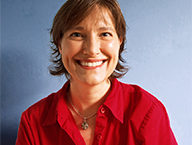The Paintings of Jane Filer
Peaceful landscapes, elaborate seascapes, sloping homes and gentle animals — this is the colorful work of local artist Jane Filer. See her latest paintings, and meet Filer in person, at the Opening Reception for her solo exhibition at Tyndall Galleries in University Mall on April 20, 2012 from 7 pm – 9 pm.
A Jane Filer Opening Reception is never a typical art opening, and this one on April 20th is no exception. This is definitely not a formal, wine and cheese, “inside-voices only” event — it’s a full-fledged party! In fact, no one would be able to hear your inside voice over the din of excitement created by all of the festivities. While surrounded by the brilliant color of twenty-six of Filer’s latest offerings hanging on the walls, there will be plenty of refreshments served, live keyboard music created by Ann Arader, and a memorable performance by Happenings — a modern, primal-drum dance of characters wearing huge, papier mache heads created by Filer, who represent various characters from her paintings coming to life and dancing in the gallery. You won’t want to miss this one! If you are interested in purchasing a painting, you will probably need to act quickly, as most of her paintings sell out within the first hour of the show, if not right when the exhibit opens on April 19th at 1:00 pm. Jane Filer’s work will be on display at Tyndall Galleries in University Mall from April 19, 2012 – May 26, 2012.
For more information about the Jane Filer Exhibition, and to view the works that will be shown, visit the Tyndall Galleries’ web site. More about Jane Filer’s paintings, her process and teachings are written below. For an in depth article about how Jane Filer became an artist and ended up living in Chapel Hill, NC, read The Chapel Hill Recorder article: “The Fantastic Jane Filer.”
THE EVOLUTION OF JANE FILER’S PAINTINGS
Jane Filer’s paintings are easily recognizable, mostly from the intensely bright color palette that lights up a room. When I saw my first Jane Filer painting at her art opening in Raleigh, NC in 1997, her style struck me as wild and courageous, with an underlying sophistication. There was a mystical darkness to her work at that time, and many of her paintings portrayed abstract figures buried underground juxtaposed with flying angels overhead. From her layering of paint and strong defining lines, a fantastic sense of movement was created in each piece, even around solid structures like houses, mountains and her ever-present animals. As a artist myself, it was obvious that Filer’s complexity of style was derived from an acute sensitivity to the fundamentals of design. Her paintings were loose and free-flowing, but behind each fantastical scene, was an artist who knew her craft well and had mastered her medium.
Fifteen years later, Jane Filer is still creating masterpieces, though the subjects of her paintings are now usually joyful and radiant. Jane explains this gradual shift from darkness to light. “The mood of my paintings has definitely changed over the years. In the nineties, I had a more primal, inert, shoot from the hip style — I just poured it out. I always tried to be honest in my art, all the way. I had some kind of crazy energy. That changed, and it became more refined, and I became more happy. And if you backed up a decade before that, they were even darker, they were nightmarish, they were spooky.” Then she adds, “The work is just constantly evolving. I can see the difference, in subtle ways. If you look back five years or ten years, it’s almost like looking at yourself five or ten years ago. It looks like you but a little bit different. And the work is just in this steady flow of evolution. It’s like an entity all its own. I guess it’s dependent on me, but it tells me what it needs and I’m just its slave. I just have different ideas and I follow that train of thought. There’s a stream of consciousness that I just run after.”
Though Filer is still working in abstraction, over time her paintings have also become more grounded in reality. “I tend to lean towards abstract that is suggestive in some way.” This slight shift away from fantasy makes her latest paintings easily accessible to the viewer, as the subjects are more recognizable and appropriate in each scene. The lines are lighter, and the compositions are thoughtfully controlled in her current body of work. Nevertheless, her style still reflects the amazing primal looseness that only Jane Filer possesses. “That’s where my art draws a very unusual line. The primitive stuff is really steeped in inert soul-grabbing stuff for me. My favorite art is ancient, old African art. I love how they make things look old, and how there’s a lot of spirit in it. It really feels what I feel. I could just zoom from prehistoric art almost totally up to post-impressionist, and that’s where art history begins for me. There’s prehistory and then there’s art history beginning with the post-impressionists.”
Recent paintings of Filer’s might be slightly more realistic, but there are often elements of the supernatural to be found in each one. “My belief is that my eyes are picking up more things on other dimensions, or within this dimension, that are just invisible or microscopic, but somehow my brain is making sense of it. I love the whole idea of spirituality, other dimensions, and thinking about what really is. A lot of times in my paintings I put in things that are floating around, like the heads in the trees. Those are like little spiritual beings. Of course I don’t really see them, but I know they are there. A lot of times I put a lot of things up in the sky. I know there’s stuff up there—I can’t see it, but I know it’s there, so I put those in my paintings. For me, art is the ability to give form to some of these things that are not there.”
What I consider to be one of the many strengths of Filer’s technique is her use of perspective, which gives endless depth to her naturescapes. The dimensional space she creates invites viewers right in, letting them breathe in the glow from the warmth of Filer’s vibrant colors. These utopian paradises of flowers and animals are places that anyone would love to visit. Each painting is a window into the world of Jane Filer, and her enthusiastic spirit of energy and light lives within her work. Filer accomplishes this through her own unique process of painting that has defined her work for over thirty years.
JANE FILER’S PROCESS
According to Jane Filer, it took years of study and experimentation before her style developed into what is now recognizable as completely her own. “Establishing a style that’s steadfast, probably took 8-10 years, through school and quite a few more years after that. That’s what it takes. That’s why it’s called art. That’s what makes the thing art. Craft, that’s another thing. If it’s a trade, that’s another thing. To say that something is art, it takes years to hone, and you’ve got to put your life into it. And it grows. It becomes more sophisticated, and it matures. And as it matures, you say, ‘Oh, wow!’ Those turns happen. At first they are kind of painful. You don’t know what to do because you’re bored with this, and you keep punching away, and you find a new vein that goes off. That can go on endlessly. That’s why the life is the work. A trade: one thing. A livelihood: another thing. Being an artist: a completely different thing. It’s kind of a devotion. But, when I was learning art, that’s exactly what I did, all over the place. That is how Jane Filer came to be, probably ten years of that. Saying, ‘Oh I’m going to try this! I’m going to try that!’ Reading art books, or seeing art in galleries inspired me to try different styles and techniques until I landed on my own style.”
Every painting of Filer’s begins the same way. Basically, she layers dark, abstract shapes all over the canvas. From these abstractions, shapes and ideas begin to form. This underpainting determines the basic subject matter. A tree might appear, or an animal or a house is created from intersecting lines. Then, using her highly-trained artistic abilities, Filer creates the composition, defining more objects by adding layers of brighter paint over these dark shapes. “It’s free flowing, but there are sensibilities involved with composition and color. It’s still abstract — I don’t know what it’s going to be. But I know that this color looks great with this, and to balance out something, it has to be over here. Some people mistake my process as random. But it’s not random. For me, every step of the way, you want to get really involved in the medium. You want to get involved in what it’s about, color theory, the actual enticing value that the medium itself can have, the thickness of the paint, the layering of the paint, and the texture of the paint is really important. And that’s not saying anything about content. That’s just technique. Technique is really important. But then there’s content, color theory and composition.” This layering from dark to light gives Filer’s work its signature complexity and interest.
Even when Jane Filer was commissioned to paint a 7′ x 45′ “Friendly Folks” mural by the Triangle Area Sister Cities for the Raleigh/Durham International Airport, Filer employed the exact same process. “I had 45 feet of panels to work with. First, the guy who made the panels used a staple gun which made these little dents. So I had to go take wood putty, and putty and sand all the dents. Then I started working with mediums and colors, just like my paintings. I pulled it out of an abstract. I knew it was going to be somewhat of a landscape. I had a couple of prototypes and models and first sketches, too. To be approved, I explained to them that I was limited by the size, even though my models were pretty big, they were nothing compared to what this thing was. So I tried to tell them I would put in more. I had my computer set up on a little table, and people would send me images, someone who worked in Africa, or Russia, and they would send pictures that they thought would be important that I might want to put in the mural. So I tried to fit it in. But it was my own process, totally. It had to be, or else it wouldn’t look good.”
Filer also works deliberately with metaphors and symbols in her paintings. “This whole world is an illusion. All we do is give meaning to things that we see. It’s symbolism because in painting you are giving form and visual expression to something esoteric, something totally invisible, something that carries with it either emotion, or a thought, or we’re injecting meaning into color or shape or objects. I use so many metaphors. Right now I’m into houses a lot, and they’re metaphors for something, though I can’t always say what they are. Metaphors work until I understand them, and then I move on to something else.”
More than anything, Jane Filer is a purist when it comes to being true to herself and her artistic process. She is often asked by galleries to replicate certain paintings that sold quickly, or she is instructed by them not to change her style too much, as people expect Jane Filer paintings to look a certain way. To those requests, Filer’s response is typically something along the lines of the following. “I just tell them, ‘If people liked what I was doing before, they are going to love what I’m doing now. Or maybe it won’t appeal to them anymore, but this is good and it will appeal to other people.’ What I did before had its own charm, its own validity. I’m not just doing this because I’m bored. I’m doing this because I’m searching for something more. This is my life’s work. This is what I pursue. Galleries once in a while will say, ‘That bird painting with the birds in it? Make more of those. I sold that in two hours.’ I could never do that. What about this whole thing I’m after, what I’m doing here? This is my work. I’m not selling things. I’m not making things to sell. This is my work. This is what I made my own tools for. This is why I live like this. This is why I don’t have kids. This is why I lived in a camper for ten years. This is what I gave up to do. This is what I struggled through school for. This is what my aunt with Alzheimer’s disease wanted for me. This is what the committee who gave me the Rickert-Ziebold Award thought I could do. Am I just going to make birds, so you can sell them? If they liked my birds, maybe they’ll like my next thing that I’m after.'”
JANE FILER’S TEACHINGS
After teaching art during graduate school at UNC Chapel Hill, and at the Carrboro ArtsCenter for 21 years, Jane Filer is a teacher, through and through. She loves supporting local up-and-coming artists, and always has sound advice to share with them. Here are some of her wise teachings about her philosophy of becoming an artist.
“As a good art student — and this is what I try to encourage — you’re exploring different things, so you can change and try something else. Your style should develop really slowly. People get in trouble when they quickly hurry and try to design a style. Then they get a gallery, and they become really bored with their own style and they want to move on to something different. But then the gallery will say, ‘People know you as this,’ so you can get trapped if you create your style too soon. People, musicians and artists, will make changes just for the sake of making changes, and they’re usually not good. They’re just bored with what they’re doing, and they find something else. But making changes and making those changes mean something meaningful, is another whole effort. When you are just starting out in art, or really any time, you should explore, look at books, look at pictures, look at magazines, think about what you want to do, and try different things, all kinds of different things. It’s a grave mistake for a lot of people to think they need to try a style way too soon. It’s really important not to do that.
“Also, develop that inner critic yourself. That’s some good advice for students. Because a lot of my students will come back and say, ‘My husband thinks such and such…’ and I’m like, ‘Who cares what your husband thinks? Are you an artist or not?’ No one tells an artist what to do! It is good to know, in classroom critiques, but these people are sometimes painting what their husbands are telling them to paint.
“I tell my students, ‘Explore. Try to make ugly colors, and you will find that you have made some really neat color.’ As an exercise, I tell them, ‘Mix something ugly,’ and as soon as you do that, you’ll say, ‘Wow I didn’t know that if I mixed orange and blue together I get this beautiful gray.’ And the next thing you do as an artist, is say, ‘Where can I use this?’ Color says so much about emotion.
“During class, my students often would come up to me and say, ‘How can I sell my art? How can I get in a gallery?’ I would answer, ‘You really better work a little more, develop more of a distinctive style first.’ Then they would reply, ‘But what am I going to I do with all these paintings?’ and my answer was always, ‘Either throw them away or paint over them.’ Whenever I would say throw them away, they would look at me like, ‘What?’ Don’t be attached to it. Be brave. Wreck it. If I was careful, if I was safe, if I was good, that wouldn’t work for me. Good, safe, okay creates nice art. You’ve got to have guts. You’ve got to be brave enough to decide, ‘You know what? This isn’t working,’ and blot something out, lob off somebody’s arm and redraw it and repaint it, or take that whole person out of the painting entirely. If you’re too careful, and if you’re too safe, and you think it’s precious, it’s going to die. Something’s going to die. That fire in you, that’s creative, it’s a human spirit thing. It’s bold, and you can’t try to be polite with it. Don’t be polite when you’re painting a painting. Just brag about how great you are! Let everybody know that you know this and that and you know this about that, and throw it all out there. When you go out into public, be polite, of course, but when you’re painting, don’t be polite. People are taught to be polite when they’re little, and they get confused when they get into art and they think you have to control these things. It’s okay to feel them, but don’t say anything about it. If somebody has saggy arm pits, and you’re drawing them, and you’re thinking about it, put them in your painting, if that’s what you want to do! Let it go, just let it out. You can see, like in my earlier work, I had a lot of crazy chaotic energy, but it worked out. You can’t just be a follower. If you’re like Jane Filer, you’re never going to be a follower. No one tells me what to do. Don’t just read about it, and think it. Take it and go out into the world and live it and be it and do it!” This courageous philosophy worked for Filer, and the Chapel Hill community is certainly better for it.
If Jane Filer’s words alone do not make you want to go out and create your own artistic vision in whatever capacity, come out to Jane Filer’s Art Opening at Tyndall Galleries on April 20, 2012, and I guarantee that one conversation with Filer will do the trick. Her enthusiasm is contagious and seeing her beautiful works of art in person is truly inspirational.
For more information about the Jane Filer Exhibition, and to view the works that will be shown, visit the Tyndall Galleries’ web site. For an in depth article about how Jane Filer became an artist and ended up living in Chapel Hill, NC, read The Chapel Hill Recorder article: “The Fantastic Jane Filer.” To view a wonderful artist profile video about Jane Filer, created and produced by local filmmaker Nic Beery, visit: http://vimeo.com/6379387.
Category: Arts & Entertainment

